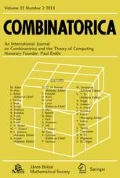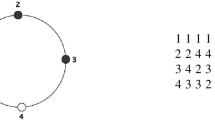Abstract
We study the computational problem of determining the covering radius of a rational polytope. This parameter is defined as the minimal dilation factor that is needed for the lattice translates of the correspondingly dilated polytope to cover the whole space. As our main result, we describe a new algorithm for this problem, which is simpler, more efficient and easier to implement than the only prior algorithm of Kannan (1992).
Motivated by a variant of the famous Lonely Runner Conjecture, we use its geometric interpretation in terms of covering radii of zonotopes, and apply our algorithm to prove the first open case of three runners with individual starting points.
Similar content being viewed by others
References
G. Averkov and A. Basu: Lifting properties of maximal lattice-free polyhedra, Math. Program. 154 (2015), 81–111.
G. Averkov and C. Wagner: Inequalities for the lattice width of lattice-free convex sets in the plane, Beitr. Algebra Geom. 53 (2012), 1–23.
J. Barajas and O. Serra: On the chromatic number of circulant graphs, Discrete Math. 309 (2009), 5687–5696.
A. Barvinok: A course in convexity, Graduate Studies in Mathematics, vol. 54, American Mathematical Society, Providence, RI, 2002.
M. Beck, S. Hoşten and M. Schymura: Lonely Runner Polyhedra, Integers 19 (2019), #A29.
T. Bohman, R. Holzman and D. Kleitman: Six lonely runners, Electron. J. Combin. 8 (2001), Research Paper 3, (electronic). In honor of Aviezri Fraenkel on the occasion of his 70th birthday.
É. Charrier, F. Feschet and L. Buzer: Computing efficiently the lattice width in any dimension, Theoret. Comput. Sci. 412 (2011), 4814–4823.
G. Codenotti, F. Santos and M. Schymura: The covering radius and a discrete surface area for non-hollow simplices, Discrete Comput. Geom. (2021), to appear, https://arxiv.org/abs/1903.02866.
Th. W. Cusick: View-obstruction problems, Aequat. Math. 9 (1973), 165–170.
S. Czerwiński and J. Grytczuk: Invisible runners in finite fields, Inf. Process. Lett. 108 (2008), 64–67.
S. Dash, N. B. Dobbs, O. Günlük, T. J. Nowicki and G. M. Świrszcz: Latticefree sets, multi-branch split disjunctions, and mixed-integer programming, Math. Program. 145 (2014), 483–508.
P. M. Gruber and C. G. Lekkerkerker: Geometry of Numbers, second ed., North-Holland Mathematical Library, vol. 37, North-Holland Publishing Co., Amsterdam, 1987.
I. Haviv and O. Regev: Hardness of the covering radius problem on lattices, Chic. J. Theoret. Comput. Sci. (2012), Article 4.
M. Henze and R.-D. Malikiosis: On the covering radius of lattice zonotopes and its relation to view-obstructions and the lonely runner conjecture, Aequat. Math. 91 (2017), 331–352.
O. Iglesias-Valiño and F. Santos: Classification of empty lattice 4-simplices of width larger than two, Trans. Amer. Math. Soc. 371 (2019), 6605–6625.
R. Kannan: Test sets for integer programs, ∀∃ sentences, Polyhedral Combinatorics, DIMACS Series in Discrete Mathematics and Theoretical Computer Science, vol. 1, Providence, RI, American Mathematical Society, 1990, 39–47.
R. Kannan: Lattice translates of a polytope and the Frobenius problem, Combinatorica 12 (1992), 161–177.
R. Kannan and L. Lovász: Covering minima and lattice-point-free convex bodies, Ann. of Math. (2) 128 (1988), 577–602.
N. Kravitz: Barely lonely runners and very lonely runners, https://arxiv.org/abs/1912.06034, 2019.
H. W. Lenstra: Integer programming with a fixed number of variables, Math. Oper. Res. 8 (1983), 538–548.
O. L. Mangasarian and T.-H. Shiau: A Variable-Complexity Norm Maximization Problem, SIAM J. Alg. Disc. Meth. 7 (1986), 455–461.
D. Micciancio: Almost perfect lattices, the covering radius problem, and applications to Ajtai’s connection factor, SIAM J. Comput. 34 (2004), 118–169.
D. Micciancio and S. Goldwasser: Complexity of lattice problems. A cryptographic perspective, vol. 671, Boston, MA: Kluwer Academic Publishers, 2002.
J. Paat, R. Weismantel and S. Weltge: Distances between optimal solutions of mixed-integer programs, Math. Program. 179 (2020), 455–468.
M. Rudelson: Distances between non-symmetric convex bodies and the MM*-estimate, Positivity 4 (2000), 161–178.
I. J. Schoenberg: Extremum problems for the motions of a billiard ball, II. The L∞ norm, in: Indag. Math., Nederl. Akad. Wetensch. Proc. Ser. A. 38, 263–279, 1976.
M. Schymura and J. M. Wills: Der einsame Läufer, Mitt. Dtsch. Math.-Ver. 26 (2018), 14–17.
T. Tao: Some remarks on the lonely runner conjecture, Contrib. Discrete Math. 13 (2018), 1–31.
The Sage Developers: Sagemath, the Sage Mathematics Software System (Version 9.1), 2020, https://www.sagemath.org.
J. M. Wills: Zur simultanen homogenen diophantischen Approximation. I, Monatsh. Math. 72 (1968), 254–263.
Acknowledgments
We thank Jörg M. Wills and Gennadiy Averkov for thorough reading of an earlier version of the manuscript, and for providing valuable comments and suggestions. We thank the anonymous referees for very careful reading and for suggestions that improved the quality of the presentation of our material.
Author information
Authors and Affiliations
Corresponding author
Additional information
Jana Cslovjecsek and Matthias Schymura were supported by the Swiss National Science Foundation (SNSF) within the project Lattice Algorithms and Integer Programming (Nr. 185030). Márton Naszódi was supported by the National Research, Development and Innovation Fund (NRDI) grants K119670 and KKP-133864, the Bolyai Scholarship of the Hungarian Academy of Sciences and the New National Excellence Programme and the TKP2020-NKA-06 program provided by the NRDI.
Rights and permissions
About this article
Cite this article
Cslovjecsek, J., Malikiosis, R.D., Naszódi, M. et al. Computing the Covering Radius of a Polytope with an Application to Lonely Runners. Combinatorica 42, 463–490 (2022). https://doi.org/10.1007/s00493-020-4633-8
Received:
Revised:
Published:
Issue Date:
DOI: https://doi.org/10.1007/s00493-020-4633-8




